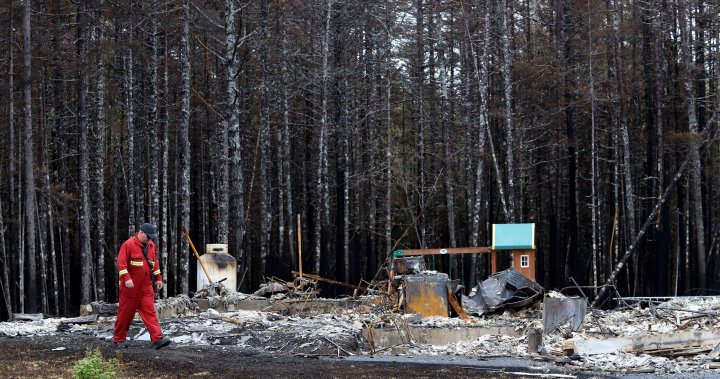Blackened trees, damaged grass, and empty land where homes once stood are still visible in a Halifax-area neighbourhood that was devastated by a historic wildfire that upended the lives of thousands one year ago.
On May 28, 2023, a wildfire broke out in the community of Upper Tantallon amid a large swath of suburban neighbourhoods surrounded by woodlands. That fire burned 969 hectares, destroyed 151 homes, and forced more than 16,000 residents to flee the area.
Another fire broke out in the neighbouring community of Hammonds Plains during the same period.
Jenny Saulnier said she was at home with her dog, Wesley, when flames started to creep into her backyard. She said she packed everything she could fit into two duffle bags before fleeing.
“I immediately felt like I needed to run for my life because of how raging it looked in the back. It was flying higher than the trees back here. It was insane. I started running and packing things,” she said.
“It was like a scene from a horror movie.”
Meanwhile in southwestern Nova Scotia, another wildfire was burning out of control and spreading across the southwestern tip of the province. The Barrington Lake fire, which broke out on May 26, burned through 23,379 hectares and took about two months to fully extinguish — solidifying itself as the largest-ever wildfire in the province’s history.
The fire forced more than 6,000 people from their homes and destroyed 60 houses and cottages, as well as 50 other structures. In January, a 22-year-old man from Shelburne County, N.S., was charged in connection with the massive wildfire and has since pled not guilty.
Breaking news from Canada and around the world
sent to your email, as it happens.
John Lohr, the minister responsible for the province’s emergency management office, described the wildfires as a “horrific events for Nova Scotians” during an interview with Global News on Monday.
“It was an unprecedented year,” he said.
Lohr said a several lessons were learned in the aftermath of last year’s wildfires.
“It’s very difficult to organize people when you’re in the middle of an emergency,” he said, adding that a volunteer-led response group and a new department of emergency management have since been formed with hopes of sharpening the province’s resources moving forward.
“Part of setting up the new department is the ongoing consultations we have with our municipal partners and police. We’ll continue to learn and make changes as needed.”
Lohr said more municipal officials have been granted access to the emergency alert system used by the province.
“The system itself belongs to the federal government, doesn’t belong to us. There’s very specific training on that and we’re increasing the number of municipal officials that can be trained,” he said.
“We’re very aware that we could have an emergency event tomorrow. Even as we’re working on this, we’re aware of that. Hopefully we’re ready for that even as we build out a new system. We’re very aware that we could be called upon at any moment.”
What’s happened since?
Since the destruction in the Upper Tantallon and Hammonds Plains area, calls have increased for an emergency egress route for the Westwood Hills neighbourhood where the wildfire began — with three potential locations identified in a staff reported presented to Halifax Regional Council in November.
“Work is ongoing and being led by the municipality’s Transportation Planning section,” a Halifax Regional Municipality report said on Monday, adding that Halifax staff are in the process of advancing planning and design work for the potential options and are expected to return with recommendations in the fall.
Also in November, Halifax launched a Voluntary Vulnerable Persons registry for residents who may require additional support during emergencies.
Discussions regarding the use of emergency alerts heightened following the wildfires, as the municipality’s public communication system hfxALERT was not activated during the event. A new coordinator, who was hired to assist with the vulnerable persons registry, is also being tasked with operating Halifax’s emergency alert system.
In December, Global News reported that Nova Scotia RCMP closed its investigation into the wildfires that burned in the Halifax area last spring, having found no criminality was involved in its cause.
It said the fire “started as a result of unextinguished (embers) from a small outdoor patio fireplace.”
A concluding report from the RCMP, dated Sept. 11, said there was insufficient evidence to proceed in the case.
In March, Nova Scotia Premier Tim Houston announced that residents who are interested in helping during natural disasters will be able to sign up for a new volunteer corps called the Nova Scotia Guard.
People with “usable skills” that could provide assistance can register with the province, which will build a pool of volunteers who first responders and community organizations can call on during or after emergencies.
The wildfires were said to have costed the Halifax Regional Municipality about $11.7 million. Since last spring, a total of 150 building permits were approved for properties that were damaged or lost.
A post-incident analysis report is currently being conducted by Halifax Regional Fire and Emergency to examine their response to last year’s wildfires, which will be shared with the public upon completion.
— with files from the Canadian Press
© 2024 Global News, a division of Corus Entertainment Inc.




